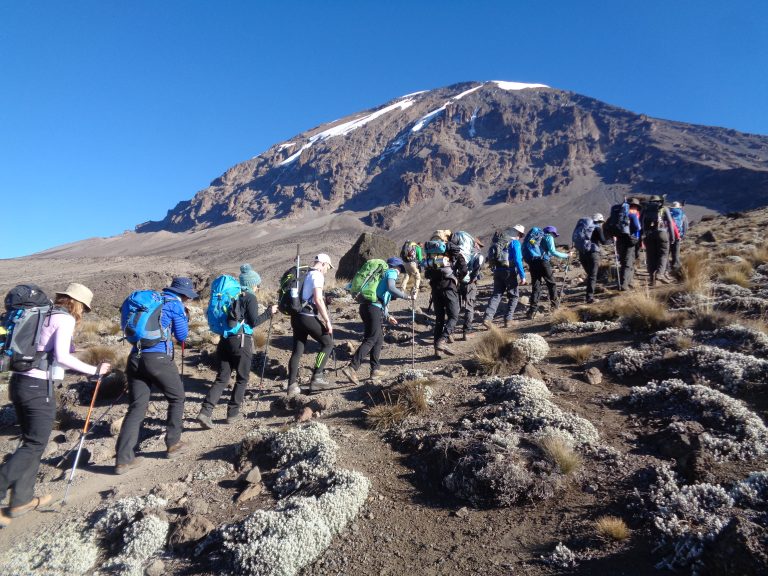Mount Kilimanjaro Trekking Routes Experiences and Level of Difficulties
Introduction to Mount Kilimanjaro Trekking Routes
Mount Kilimanjaro, Africa’s tallest peak, is a dream destination for many hikers. While it doesn’t require technical climbing skills, Kilimanjaro’s diverse trekking routes offer varying levels of difficulty and unique experiences for climbers. Here, we’ll explore the main Mt. Kilimanjaro trekking routes, their difficulty levels, and what climbers can expect from each path on their journey to the summit.
Overview of Mt. Kilimanjaro Trekking Routes
Kilimanjaro has several primary trekking routes, each with its own landscape, challenges, and appeal. Here are the main routes used by climbers:
- Marangu Route
- Difficulty Level: Moderate
- Experience: Often referred to as the “Coca-Cola Route,” Marangu is known for its relatively easy access and hut accommodations along the way. It’s the only route with dormitory-style huts instead of camping, making it a comfortable choice for those new to high-altitude trekking. However, the shorter ascent time means less time for acclimatization, increasing the risk of altitude sickness.
- Machame Route
- Difficulty Level: Challenging
- Experience: Known as the “Whiskey Route,” the Machame Route is one of the most popular due to its stunning scenery and gradual acclimatization. Climbers encounter dense rainforests, moorlands, and the famous Lava Tower as they progress upward. Machame requires more endurance than Marangu due to its longer and steeper trail, but the gradual ascent improves acclimatization.
- Lemosho Route
- Difficulty Level: Challenging
- Experience: Often considered one of the most scenic routes, Lemosho offers a high success rate due to its longer duration, which allows for better acclimatization. Starting from the west, climbers journey through a remote and varied landscape, from lush forests to arid high-altitude deserts. It eventually joins the Machame Route, giving climbers a chance to experience some of the best viewpoints Kilimanjaro has to offer.
- Rongai Route
- Difficulty Level: Moderate to Challenging
- Experience: Rongai is the only route that approaches Kilimanjaro from the north, near the Kenyan border. This quieter path is ideal for those seeking a less crowded experience. Although not as scenic as other routes, it offers a gradual ascent, which reduces the risk of altitude sickness. Rongai is also known for being relatively dry, making it a good option during the rainy season.
- Umbwe Route
- Difficulty Level: Very Difficult
- Experience: Umbwe is the shortest and steepest route on Kilimanjaro, reserved for highly experienced climbers or those seeking a true challenge. It requires strong physical endurance and is not recommended for beginners. Umbwe offers a direct, rapid ascent that can increase the risk of altitude sickness due to limited time for acclimatization.
- Northern Circuit Route
- Difficulty Level: Moderate to Challenging
- Experience: This is the longest route, taking up to nine days to complete. It circles around the northern side of the mountain, providing incredible panoramic views and optimal acclimatization opportunities. The extended duration makes it a top choice for climbers seeking a higher chance of reaching the summit comfortably, though the length requires considerable endurance.
Factors Impacting the Difficulty of Mt. Kilimanjaro Trekking Routes
Kilimanjaro’s routes vary not just in distance and elevation but also in terrain, climate, and acclimatization opportunities. Here are the key challenges climbers face:
- Altitude and Acclimatization
- Kilimanjaro’s elevation can be tough on the body, especially as oxygen levels decrease at higher altitudes. Routes like Lemosho and Northern Circuit offer gradual ascents, allowing for better acclimatization, while steep routes like Umbwe challenge climbers more quickly.
- Physical Endurance and Stamina
- Kilimanjaro’s trails cover diverse terrains—from dense forests and rocky landscapes to alpine deserts. Climbers need a moderate to high level of physical fitness to handle the varied terrain, especially on longer routes such as Machame and Lemosho. Routes like Umbwe demand peak endurance, as the steep inclines and rapid ascent can be exhausting.
- Weather and Temperature Changes
- Climbers experience significant temperature shifts, with tropical rainforests at the base and freezing temperatures at the summit. Certain routes, like Rongai, are less affected by rain, making them preferable in wet seasons. However, the exposed summit can still bring freezing conditions on any route, demanding preparation for extreme cold.
- Summit Night Challenge
- Regardless of the route, summit night is a grueling experience. Climbers usually start around midnight to reach the summit by sunrise, navigating steep, rocky terrain in freezing temperatures. The combination of darkness, altitude, and fatigue makes this the hardest part of any route.
Choosing the Right Mt. Kilimanjaro Trekking Route
Selecting the best route depends on a climber’s experience, physical fitness, and preference for scenery or acclimatization. Here’s a quick guide:
- For Beginners: Marangu Route (comfortable but less time for acclimatization) or Rongai Route (gradual ascent, less crowded).
- For Scenic Views and Acclimatization: Lemosho Route or Northern Circuit, both of which offer extended time on the mountain and scenic landscapes.
- For Experienced Climbers: Umbwe Route, which is short but requires high stamina and is best suited to those familiar with high-altitude trekking.
Final Thoughts on Mt. Kilimanjaro Trekking Routes
Each of Kilimanjaro’s routes provides a unique experience, from the bustling paths of Machame to the serene landscapes of the Northern Circuit. While all routes eventually lead to the summit, the journey and challenges differ, allowing climbers to tailor their adventure to their personal preferences and abilities. Conquering Kilimanjaro is a remarkable achievement, with each route presenting its own way to experience Africa’s tallest mountain.


One Comment